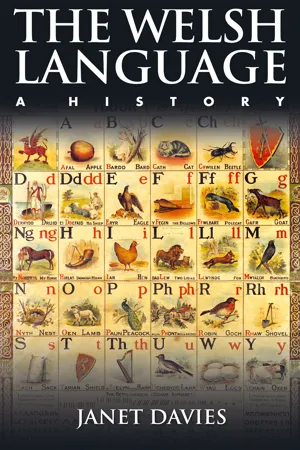
- English
- ePUB (mobile friendly)
- Available on iOS & Android
About this book
The existence of the Welsh-language can come as a surprise to those who assume that English is the foundation language of Britain. However, J. R. R. Tolkien described Welsh as the 'senior language of the men of Britain'. Visitors from outside Wales may be intrigued by the existence of Welsh and will want to find out how a language which has, for at least fifteen hundred years, been the closest neighbour of English, enjoys such vibrancy, bearing in mind that English has obliterated languages thousands of miles from the coasts of England. This book offers a broad historical survey of Welsh-language culture from sixth-century heroic poetry to television and pop culture in the early twenty-first century. The public status of the language is considered and the role of Welsh is compared with the roles of other of the non-state languages of Europe. This new edition of The Welsh Language offers a full assessment of the implications of the linguistic statistics produced by the 2011 Census. The volume contains maps and plans showing the demographic and geographic spread of Welsh over the ages, charts examining the links between words in Welsh and those in other Indo-European languages, and illustrations of key publications and figures in the history of the language. It concludes with brief guides to the pronunciation, the dialects and the grammar of Welsh.
Frequently asked questions
- Essential is ideal for learners and professionals who enjoy exploring a wide range of subjects. Access the Essential Library with 800,000+ trusted titles and best-sellers across business, personal growth, and the humanities. Includes unlimited reading time and Standard Read Aloud voice.
- Complete: Perfect for advanced learners and researchers needing full, unrestricted access. Unlock 1.4M+ books across hundreds of subjects, including academic and specialized titles. The Complete Plan also includes advanced features like Premium Read Aloud and Research Assistant.
Please note we cannot support devices running on iOS 13 and Android 7 or earlier. Learn more about using the app.
Information
The Origins of Welsh
The Indo-European family of languages
| WELSH | LATIN | ENGLISH | SANSKRIT |
| ieuanc | juvenis | young | yuvan |
| dant | dens | tooth | danta |
| tenau | tenuis | thin | tanas |
| gweddw | vidua | widow | mi vidhava |
| tri | tres | three | trayas |


in Europe and Asia
The Celts
| WELSH | BRETON | IRISH | GAELIC |
| tŷ (house) | ti | teach | tigh |
| ci (dog) | ki | cu | cu |
| du (black) | du | dubh | dubh |
| cadair (chair) | kador | cathaoir | cathair |
| gwin (wine) | gwin | fion | fion |
The Brittonic language
| WELSH | LATIN |
| pont (bridge) | pons |
| eglwys (church) | ecclesia |
| lleng (legion) | legio |
| ystafell (room) | stabellum |
| trawst (joist) | transtrum |
| bresych (cabbage) | brassica |
The impact of Rome
Table of contents
- Half Title
- Title Page
- Copyright
- Contents
- List of Illustrations
- List of Maps
- Acknowledgements
- The Welsh Language: A Personal Perspective
- 1: The Origins of Welsh
- 2: Welsh in the Early British Kingdoms
- 3: Welsh in the Middle Ages
- 4: From the Act of ‘Union’ to the Industrial Revolution
- 5: The Welsh Language in the Era of Industrialization
- 6: Welsh in the Later Nineteenth Century
- 7: Welsh in the First Half of the Twentieth Century
- 8: The Second World War and After
- 9: The Welsh Language Today
- 10: Welsh and the Other Non-State Languages of Europe
- 11: The Characteristics of Welsh
- Postscript
- Further Reading